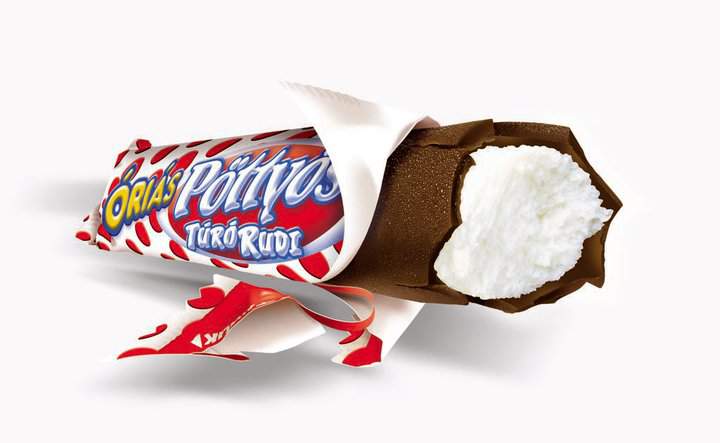Cottage cheese and chocolate – the story of Túró Rudi
Túró Rudi is quite a unique type of dessert in Hungary and some neighboring countries. It is a chocolate bar filled with a dairy cream resembling to cottage cheese, from which it received its name (“túró” means cottage cheese in Hungarian, while “Rudi” can both refer to “rod” or the nickname of Rudolf). Its special taste and iconic packaging (white with red dots) is well known by Hungarians and tourists alike.
The history of Pöttyös Túró Rudi began in 1954 when three Hungarian experts of the dairy industry went to the USSR to study the Soviet dairy. They saw a product which is considered to be the predecessor of Túró Rudi, as Pottyos.hu claims.
Manager of the milk factory in Erzsébetváros Rudolf Mandeville received a request to develop the Soviet product, adding some Hungarian taste to it. He successfully adapted the “cottage cheese cupcake”. The next issue was the marketing of the product.
There were no marketing experts at that time, so a young psychologist, Sándor Klein got the task of designing a profile for the advertisements.
He named the product Túró Rudi and he also came up with the idea of the red dotted packaging. The original packaging, which depicted the head of a little girl, was created by two of Klein’s students, according to Penzcentrum.
Production began in Budapest in 1968, but this factory was in function only for a short time. The first production machinery — which was made of wood — was transported to Szabolcs county.
Though Túró Rudi had a very short expiration time — about three days — it did not mean any problem as the product was always sold in a very short time.
The manufacture was replaced to Mátészalka in 1970. An old cottage cheese factory was the new venue of production: it consisted of only two rooms and the cottage cheese was made in a container of 10,000 liters. At the beginning, 25-30 employees were working with the machinery in three shifts.
A bar of Túró Rudi weighed three dekagrams at that time and it was sliced relying on comprehensive glance.
The renewal of the brand was done in the 80s and 90s. That was the period when flavored Túró Rudi bars appeared, namely hazelnut and peanut flavors. Túró Rudi was also opening to healthy lifestyle: Kalci Rudi (with calcium) and Cinki Rudi (with zinc) were introduced, as well as Xilites Rudi (with xylitol), Túró Robi and Túró Aktivit.
In the early 2000s several new types appeared: Túró Rudi with raisins or peanut butter, the one with milk coating, and packages containing multiple bars. 2007 was also a productive year concerning novelties: Túró Bonbon (Túró Rudi pralines) and Pöttyös Jégkrém (Túró Rudi ice cream were introduced).
240 employees are working today in the factory in Mátészalka.
They have passed the five billionth Túró Rudi bar a couple of years ago.
This means that if someone put all the Túró Rudi bars ever made after one another, it would circle around the globe fifteen times, according to the estimation of Turizmus Online. Túró Rudi is so popular among Hungarians that they often make cakes at home based on the ingredients of the chocolate bar.
Photo: Facebook.com/turorudi
Ce: bm
Source: Turizmus Online, Pottyos.hu, Illum-Marketing, Penzcentrum
please make a donation here
Hot news
What happened today in Hungary – 26 July, 2024
Drama: number of births in a 20-year low in Hungary
Yay or nay? – 6 odd Hungarian delicacies that make our skin crawl
Budapest tourism “exploded” this past weekend
Container transport in Budapest may stop: How will this affect Hungarian economy?
Minister: Hungary will protect its territory by every means possible





2 Comments
You can buy the original taste in a Lithuanian shop….product name is different, obviously
cool